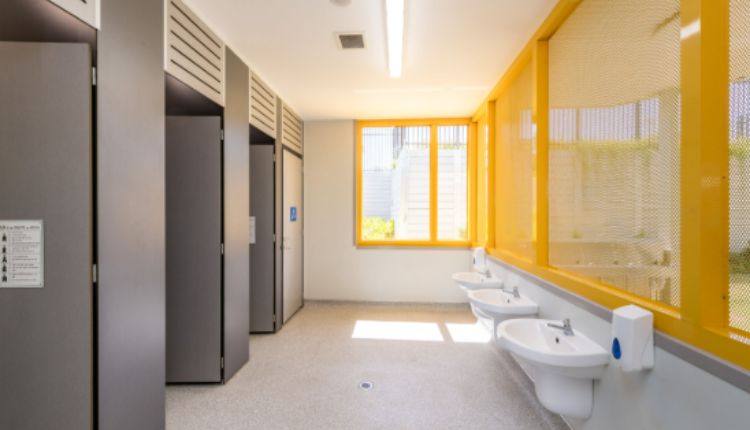School restrooms often get overlooked in conversations about educational equity and student well-being. But for many students—especially those who are transgender, nonbinary, or living with disabilities—restrooms can become sources of stress, exclusion, or even fear. It’s time for that to change.
Creating school restrooms that are safe, inclusive, and respectful of every student’s identity is more than just a facilities upgrade. It’s a step toward affirming human dignity. Let’s explore how thoughtful restroom design can transform a basic need into a powerful statement of inclusion.
Why School Restrooms Matter
At first glance, a restroom might seem like a minor detail in a school’s design. But in practice, it can hold enormous emotional weight. Students visit restrooms multiple times a day, and the experience can impact their sense of safety and belonging.
For transgender and nonbinary students, choosing between gendered restrooms often means choosing between harassment or exclusion. Students with disabilities may find facilities inaccessible or poorly maintained. Even younger students can face stress when privacy isn’t guaranteed.
School restrooms are more than just practical—they are deeply personal. And when students feel safe using them, they can better focus on learning.
Understanding the Barriers
Several challenges stand in the way of inclusive restroom design:
- Gender-segregated layouts that don’t accommodate nonbinary or transitioning students.
- Lack of privacy due to gaps in stalls or shared open areas.
- Inaccessible facilities for students with mobility, sensory, or developmental challenges.
- Poor maintenance or outdated materials that make spaces feel unsafe or unhygienic.
These problems don’t just cause discomfort—they contribute to absenteeism, anxiety, and in some cases, health risks from students avoiding the bathroom altogether.
According to the National Center for Transgender Equality, over 70% of transgender youth avoid using school bathrooms because they feel unsafe or unwelcome. This is not a marginal issue—it’s a serious equity concern.
Key Features of Inclusive, Dignified Restrooms
Redesigning school restrooms doesn’t have to be expensive or disruptive. The most effective solutions are based on respect, privacy, and universal design principles.
Here are some critical elements:
1. Single-Occupancy and All-Gender Options
Installing single-occupancy restrooms or all-gender facilities allows students to choose a space without disclosing or defending their gender identity. These designs are simple, flexible, and suitable for everyone.
2. Privacy-First Partitions
One of the easiest wins in creating inclusive restrooms is installing floor-to-ceiling stalls with minimal gaps. These provide visual and auditory privacy for all students, which benefits everyone—not just those facing gender-based discomfort.
Facilities directors should prioritize choosing school bathroom partitions that emphasize durability, ease of cleaning, and complete privacy. Modern partitions come in a variety of materials and designs that serve both practical and psychological needs.
3. Accessible Layouts for All Bodies
Restroom design must meet ADA standards, but inclusive design goes beyond the bare minimum. That means ensuring:
- Grab bars are correctly placed.
- Sinks and dryers are within reach.
- Wayfinding signage includes braille and symbols.
- Color contrasts help those with low vision.
Thoughtful design communicates that every student matters.
Choosing Materials and Fixtures that Support Well-Being
A restroom’s atmosphere significantly affects how students feel while using it. Bright lighting, neutral colors, and well-ventilated spaces foster a sense of comfort and safety. Anti-microbial surfaces, touchless fixtures, and quality flooring reduce maintenance demands while improving hygiene.
It’s also important to use vandal-resistant materials and smart layouts to reduce maintenance concerns. But this shouldn’t come at the cost of student comfort. Designing for durability doesn’t mean sacrificing dignity.
Involving Students in the Design Process
One of the most overlooked steps in transforming school restrooms is engaging the very people who use them—students. Their input can guide improvements that administrators might miss.
School leaders can:
- Conduct anonymous surveys about bathroom experiences.
- Host student focus groups to gather specific feedback.
- Include student representatives in facilities committees.
When students see their feedback reflected in real changes, it sends a powerful message: your comfort and safety are a priority.
Overcoming Pushback and Building Consensus
Not every school community embraces change right away. Some stakeholders may express concern about cost, tradition, or misunderstandings around gender identity.
Transparent communication is key. Frame the conversation around safety, privacy, and equal access. Emphasize that inclusive restroom design benefits everyone—from young children who need supervision to students with sensory challenges.
Share success stories from other districts. For example, Edutopia offers detailed examples of schools that have implemented inclusive bathroom designs with overwhelmingly positive feedback.
Administrators should also consult legal experts to ensure compliance with both federal mandates and state laws regarding gender rights and accessibility.
Creating a Lasting Culture of Respect
Redesigning restrooms is just one piece of the puzzle. For changes to be effective, schools must also address the culture surrounding them.
This includes:
- Updating school policies to reflect inclusive practices.
- Training staff on restroom-related student rights.
- Teaching students about respect, diversity, and boundaries.
Physical spaces shape behavior—but policies and culture sustain change.
Final Thoughts
Inclusive restroom design is not just a facilities issue—it’s a human rights issue. When schools take the time to invest in privacy, accessibility, and choice, they create environments where all students can thrive.
Every student deserves to feel safe and respected, even in the most ordinary of moments. By reimagining school restrooms as spaces of dignity rather than discomfort, educators send a powerful signal: everyone belongs.






